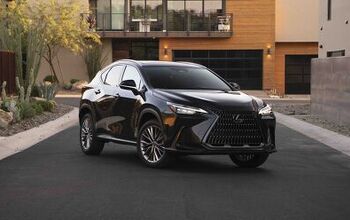2009 Volkswagen CC

Sold as the Passat CC in some markets, in the U.S. it’s just called the CC – a wise choice by the suits at Volkswagen.
FAST FACTS
| 1. The CC can be had as a 207hp 2.0T or 280hp 3.6-liter V6 in either front-wheel drive or 4Motion all-wheel drive. (The V6 is only available in 4Motion trim in Canada). |
| 2. With a price of $39,800 the VR6 4Motion gets 17/25 mpg and goes from 0 to 60 mph in 6.2-seconds. The $27,100 base 2.0T FWD model is also impressive with 21/31 mpg and a 0-60 mph time of 6.9-seconds. |
| 3. Unlike luxury competitors, premium fuel is recommended but not required. |
| 4. The CC is a four-seater |
You see, the CC isn’t really a Passat at all, and has an entirely new platform. This isn’t just a different looking car from VW; it’s a different kind of car.
For starters, it’s one of those four-door coupes. Mercedes started the four-door coupe talk with the CLS and the design of the CC is reminiscent (read: stolen) from that other German sedan. We can’t hold that against the car though, as it is a brilliant piece of sheet metal.
Another coupe trait is the frameless doors. The CC also gets a more prominent front grille compared to the other VW models and a nice front radiator space with a large opening. Strong lines run across the side of the car, making for an attractive profile, however, while the CC is stunning from almost every angle, the rear isn’t one of them.
The drive of the CC is also much more like a coupe than a sedan – or at least like a nice and sporty sedan. I was impressed with the power, handling and driving feel of my VR6 4Motion tester, even after having spent the previous week behind the wheel of an Audi A4 3.2.
Which brings me back to the name. I’m sure a lot of people reading this article are those who picked up on the Passat name, who own a Passat and who are thinking about a new one. I’m honestly not sure if this is the right car for them. The people who really should be reading this are A4, C-Class, IS, G and 3 Series drivers. It’s also a great alternative to even higher model than those. Yes, it’s that good.
Let me explain.
FULL-ON LUXURY INTERIOR
As the rear doors and rear seat room of most entry-level luxury cars don’t often get utilized, those customers wouldn’t mind the fact that the CC has just four seats. This unique layout also means that the rear seat area is more luxurious with individual spaces for the two rear passengers.
Up front the luxury is definitely up to par with leather surfaces on all but the lowest (Sport 2.0T FWD) trim. And it’s more than just plain-old leather seats; the inserts are stitched in a thick bar-pattern like a classic muscle car and are extremely supportive. Front seats are heated with 12-way adjustability with 4-way lumbar support and a three-position driver memory setting.
All models get a tilt and telescopic leather-wrapped steering wheel with audio controls and VR6 models get paddle shifters for the tiptronic six-speed automatic transmission. The audio controls aren’t the most ergonomic, however. Cruise control is standard and is located on a separate stalk.
I absolutely loved the raised center console, which gives a great sports car-like feel to the cockpit, with everything close at hand.
Other interior highlights include power windows with one-touch for the front and a multi-function computer that shows mpg, trip settings and other info. VR6 models also come standard with dual-zone climate control, homelink and a 600-watt 10-speaker sound system – although a navigation system is optional on all models. The CC also comes with an auto-hold parking brake, ideal for stopping and starting on steep inclines.
One thing that seems missing in the CC, however, is a smart-key and push-button ignition. With such a modern looking car that is so luxurious inside, it seems a pity to have to actually push that plastic key into the plastic slot in the dash.
IMPRESSIVE, ALMOST V8-LIKE, 280HP V6 ENGINE
When you do though, the sound is surprising. When the V6 under the hood comes to life it’s more like an 8. It continues to sound that way when you’re out driving about too, with a nice rumble and growl. Impressively, it feels a lot like an 8 as well.
The 3.6-liter engine generates its power at low rpm with 280hp at 6200 rpm and 265 ft-lbs of torque at 2750 rpm. VW says this translates to a 0-60 time of 6.2 seconds with the heavier but better-gripping 4Motion. Fuel-economy is rated at 17/25 mpg (city/highway) with a noticeably better 18/27 mpg rating for the front-wheel drive VR6 model (which is only available in the U.S.).
Premium fuel is recommended, but not required.
SOLID AND HEAVY STEERING
Thanks to a sportier suspension and more responsive steering than the Passat, the CC is a pleasure to drive. The 235/40-series tires, wrapped around 18-inch wheels, don’t hurt either – although the wheel design was a touch too hip-hop for my tastes.
Steering feel is heavy and incredibly direct – unlike the often-sloppy feel you get in many cars with variable ratio steering systems. This means that it requires a little more effort at low speed (something I actually prefer) and tracks straight as an aero on the highway. (This car definitely gets an A+ on the autobahn test).
With an up-front seating position and a short front overhang the view of the road is excellent, although we can’t exactly say the same for the rest of the angles. When you first slide into the CC and close that door it feels almost coffin-like with stubby little windows and a tiny rear area. Just because the windows don’t let in a lot of light, however, doesn’t mean the blind spots were all that bad – although the side mirrors could use to be a little larger.
And when it comes to letting in the light, that task is best handled by the massive panoramic sunroof that covers the entire front-half of the roof.
In the safety department the CC is well equipped with driver and passenger front and side airbags and curtain airbags for front and rear. (Rear side airbags are optional). Stability control comes standard, as does ABS with anti-slip regulation (ASR) and Brake Assist.
DOLLARS AND CENTS
The starting price of the CC is almost $1,000 less than a Passat, but don’t let that fool you. That Passat is pretty much a get-what-you-see type of car, whereas the different CC trims can raise the price quite a bit. A VR6 4Motion model, like our test car, comes in at $39,800 ($44,975 CDN). That might seem like a lot for the VW, but the CC is no more a Golf than an A4 is.
At that price it is right in line with the offers from BMW, Audi and the Japanese luxury brands.
As the CC will no doubt appeal to a younger generation of buyers as well, it’s important to point out just how good the base 2.0T model is. At $27,100 ($31,975 CDN) the front-wheel drive, six-speed manual 2.0T gets 200hp and 207 ft-lbs of torque. This gives it a still-impressive 0-60 mph time of 6.9 seconds and an excellent fuel-economy rating of 21/31 mpg (city/highway).
THE VERDICT
Base or fully loaded, the CC is a full-package vehicle with an impressive exterior design, excellent interior quality, plenty of power and a feel behind the wheel that is hard to match. Volkswagen is a company that constantly battles with an interior corporate struggle between building functional “people’s cars” and performance vehicles. This time the performance side won and we couldn’t be happier.
PLUS
- Cutting-edge style
- Heavy and direct steering
- Range of models and prices
MINUS
- No push-button start
- Tiny wheel-mounted audio controls
- Small side mirrors

With AutoGuide from its launch, Colum previously acted as Editor-in-Chief of Modified Luxury & Exotics magazine where he became a certifiable car snob driving supercars like the Koenigsegg CCX and racing down the autobahn in anything over 500 hp. He has won numerous automotive journalism awards including the Best Video Journalism Award in 2014 and 2015 from the Automotive Journalists Association of Canada (AJAC). Colum founded Geared Content Studios, VerticalScope's in-house branded content division and works to find ways to integrate brands organically into content.
More by Colum Wood



















![2011 Buick Regal Review [Video]](https://cdn-fastly.autoguide.com/media/2023/06/26/06071/2011-buick-regal-review-video.jpg?size=350x220)











Comments
Join the conversation